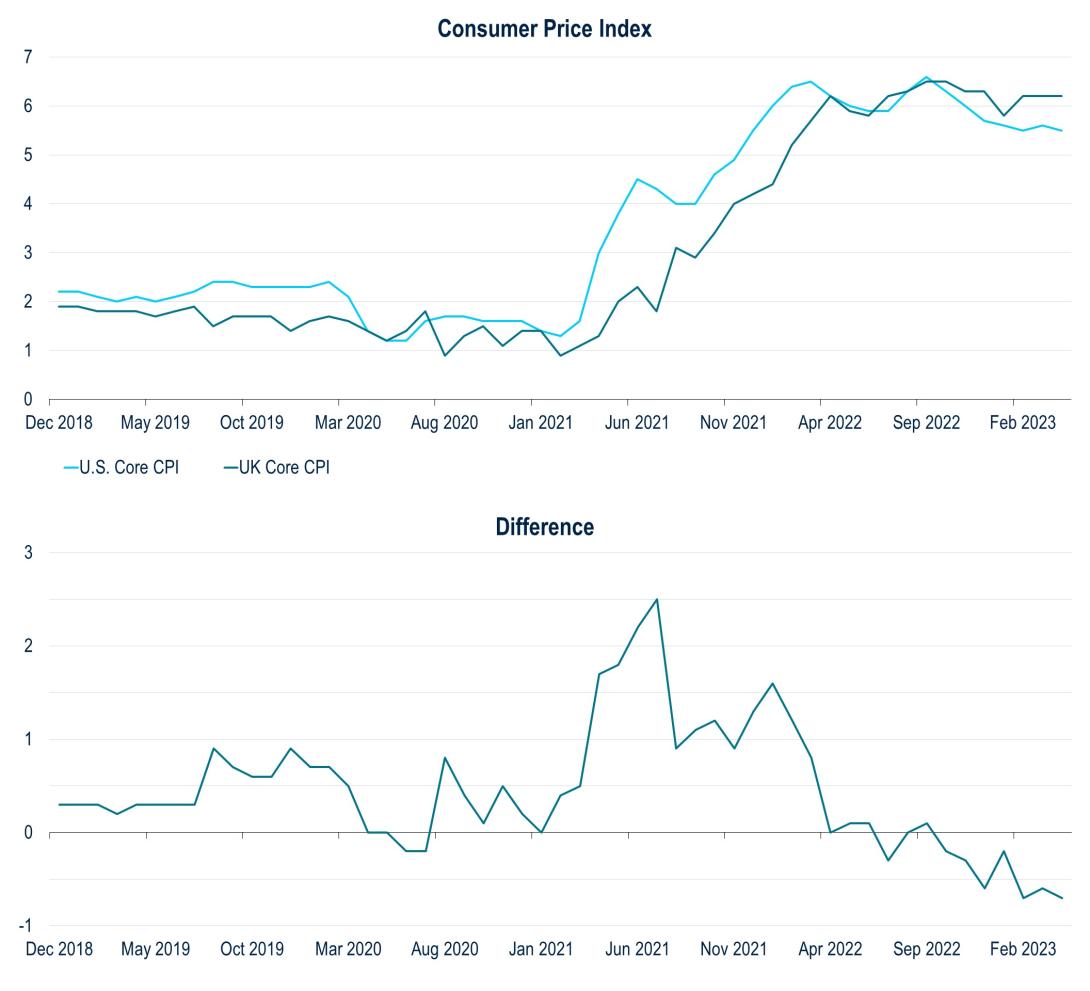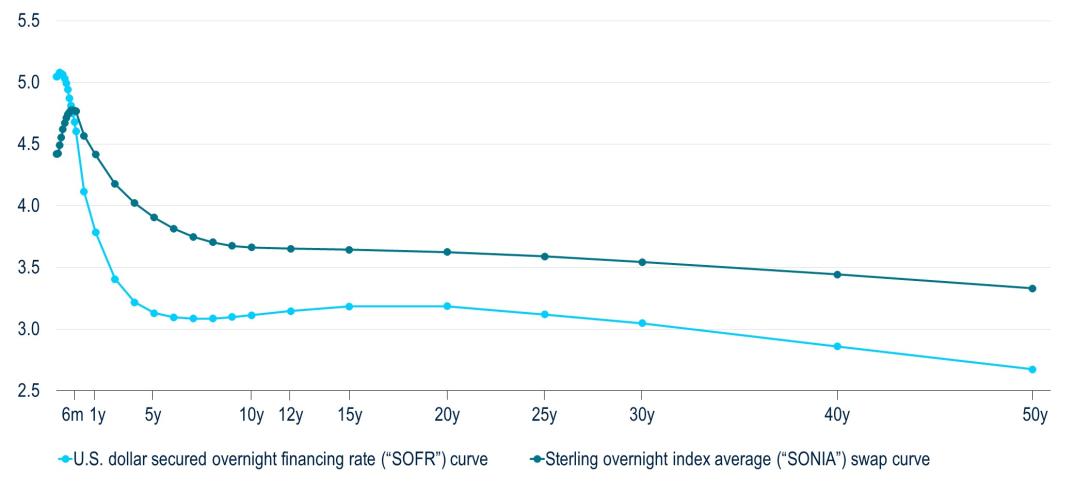The Bank of England Buys Itself Time

The BoE delivered no surprise today when it raised its main policy rate (“Bank Rate”) a further 25 basis points (bps) to 4.5%. But the Bank’s messaging distinguished it from the Fed’s and the ECB’s decisions last week.
The Fed signaled a likely pause last week, and the ECB remained hawkish, with the prospect of further hikes. By contrast, the BoE kept the door open to either. On the one hand, it expects nominal price pressures to remain resilient, pointing to higher rates or higher-for-longer rates. On the other hand, the Bank’s tightening to date has been substantial and is yet to feed through to the real economy.
The key question for us is whether UK policy rates can sustainably decouple if and when the Fed cuts rates, possibly later this year. In such a scenario, we see higher-for-longer UK rates as likely – i.e., rates peaking close to the current level and remaining there for longer as inflation slowly grinds back to the 2% target.
Our Take on The Policy Meeting
Against a fragile global backdrop of banking stresses and U.S. debt-ceiling woes, the BoE did well to not deliver an additional surprise. But the Bank’s updated assessment of the UK economy was interesting. The Bank revised its GDP outlook markedly higher, such that it no longer expects the UK to slip into recession this year. That said, the growth outlook remains exceptionally weak.
Also interesting was the BoE’s assessment that, to date, the impact of U.S. banking stress on UK credit conditions has been small. This judgment aligns with our view that there has been limited contagion from the U.S. banking sector to Europe. However, the UK is not immune to spillovers from the U.S. A weaker U.S. economy would translate into reduced demand for UK exports and slower overall economic activity, potentially reducing the need for further rate rises.
Finally, the Bank’s messaging focused on the prospects of prolonged above-target inflation. It now expects second-round effects of higher wages and inflation expectations to take longer to unwind than when they emerged. This reassessment of the stickiness of inflation would, at the margin, translate into further interest rate rises.
Our base case is that the BoE has bought itself time to assess where it goes next with interest rates. If the UK economy evolves in line with its projections, we see Bank Rate peak at its current 4.5%, with perhaps another quarter point hike in June or August before pausing. We see resilience in inflation as indicating higher-for-longer interest rates, rather than ever higher rates.
Market Reaction
As explained above, the Fed, ECB and BoE’s 25 bps increases mask different postures, with the BoE showing the steadiest direction of travel. The BoE appeared confident today that it has done enough to bring inflation back to target. There was little in its press release or press conference to alter market pricing in Gilts or other UK markets. However, there are three important points of note from a market perspective.
First, UK economic data has been more challenging for markets than data in the U.S. and the eurozone. In particular, UK core inflation remains stubbornly high, relative to U.S. inflation, which started to fall last September (Figure 1). UK activity has also been better than feared. UK economic data surprises, for example, have been positive and rising in recent months, in contrast with the U.S. and the eurozone, where they have decelerated (Figure 2).
Figure 1: UK Core Inflation Versus U.S. Core Inflation (%)

Source: Bloomberg, PGIM Fixed Income. As of 11 May 2023.
Figure 2: UK Economic Surprises are Positive and Rising, while U.S. and eurozone Economic Surprises Are Falling (Index Level)

Source: Citi. As of 11 May 2023.
Second, this diverging economic data has led to diverging expectations for central bank rates. Investors expect the UK to raise rates or keep them higher for longer as the U.S. embarks on a rate-cutting cycle. Market pricing indicates two more BoE hikes by September, but expects the U.S. to cut rates once by then. These are truly diverging policies (Figure 3).
Figure 3: Policy Divergence Between the BoE and the Fed is notable (%)

Source: Bloomberg, PGIM Fixed Income. As of 11 May 2023.
Finally, we think that the above divergence may eventually ease for two key reasons.
- First, from a pure policy perspective, the Fed rate cuts priced into short-dated U.S. interest rates could reverse, given signs that core services inflation (ex-shelter), c. 55% of the core PCE (Personal Consumption Expenditures) basket, remains persistent. At the same time, investors’ anxiety associated with U.S. regional banks could ease. However, developments with the U.S. debt ceiling may lead to anomalies across the short-dated end of the U.S. yield curve.
- Second, the UK Gilts market doesn’t seem to reflect that the effect of energy prices on UK inflation will reverse in coming months, leading to significant downside surprises. That should lead to lower UK interest rates and a steeper UK yield curve. The UK 2-year/10-year Gilts curve, for example, has flattened since mid-April, while the U.S. Treasury 2-year/10-year yield curve has steepened by c. 20 bps. Relatedly, the easing of the UK versus U.S. interest rate differential could lead to some reversal in the GBP/USD exchange rate, after its 4% rally since early March.
Overall, the BoE’s decision didn’t surprise investors. If anything, the Bank’s messaging was less definite in term of direction, compared to the more hawkish ECB and more dovish Fed. Investors are, however, pricing in an important policy divergence between the Fed and the BoE. Interesting investment opportunities could emerge if that divergence doesn’t fully materialize.
Figure 4: The UK Gilts 2-year/10-year yield curve has flattened over the past month, while the U.S. Treasury 2-year/10-year yield curve has steepened (bps)
 Source: Bloomberg, PGIM Fixed Income. As of 11 May 2023.
Source: Bloomberg, PGIM Fixed Income. As of 11 May 2023.
Read More From PGIM Fixed Income
The comments, opinions, and estimates contained herein are based on and/or derived from publicly available information from sources that PGIM Fixed Income believes to be reliable. We do not guarantee the accuracy of such sources or information. This outlook, which is for informational purposes only, sets forth our views as of this date. The underlying assumptions and our views are subject to change. Past performance is not a guarantee or a reliable indicator of future results.
Source(s) of data (unless otherwise noted): PGIM Fixed Income, as of 5/11/2023.
For Professional Investors only. Past performance is not a guarantee or a reliable indicator of future results and an investment could lose value. All investments involve risk, including the possible loss of capital.
PGIM Fixed Income operates primarily through PGIM, Inc., a registered investment adviser under the U.S. Investment Advisers Act of 1940, as amended, and a Prudential Financial, Inc. (“PFI”) company. Registration as a registered investment adviser does not imply a certain level or skill or training. PGIM Fixed Income is headquartered in Newark, New Jersey and also includes the following businesses globally: (i) the public fixed income unit within PGIM Limited, located in London; (ii) PGIM Netherlands B.V., located in Amsterdam; (iii) PGIM Japan Co., Ltd. (“PGIM Japan”), located in Tokyo; (iv) the public fixed income unit within PGIM (Hong Kong) Ltd. located in Hong Kong; and (v) the public fixed income unit within PGIM (Singapore) Pte. Ltd., located in Singapore (“PGIM Singapore”). PFI of the United States is not affiliated in any manner with Prudential plc, incorporated in the United Kingdom or with Prudential Assurance Company, a subsidiary of M&G plc, incorporated in the United Kingdom. Prudential, PGIM, their respective logos, and the Rock symbol are service marks of PFI and its related entities, registered in many jurisdictions worldwide.
These materials are for informational or educational purposes only. The information is not intended as investment advice and is not a recommendation about managing or investing assets. In providing these materials, PGIM is not acting as your fiduciary. PGIM Fixed Income as a general matter provides services to qualified institutions, financial intermediaries and institutional investors. Investors seeking information regarding their particular investment needs should contact their own financial professional.
These materials represent the views and opinions of the author(s) regarding the economic conditions, asset classes, securities, issuers or financial instruments referenced herein. Distribution of this information to any person other than the person to whom it was originally delivered and to such person’s advisers is unauthorized, and any reproduction of these materials, in whole or in part, or the divulgence of any of the contents hereof, without prior consent of PGIM Fixed Income is prohibited. Certain information contained herein has been obtained from sources that PGIM Fixed Income believes to be reliable as of the date presented; however, PGIM Fixed Income cannot guarantee the accuracy of such information, assure its completeness, or warrant such information will not be changed. The information contained herein is current as of the date of issuance (or such earlier date as referenced herein) and is subject to change without notice. PGIM Fixed Income has no obligation to update any or all of such information; nor do we make any express or implied warranties or representations as to the completeness or accuracy.
Any forecasts, estimates and certain information contained herein are based upon proprietary research and should not be interpreted as investment advice, as an offer or solicitation, nor as the purchase or sale of any financial instrument. Forecasts and estimates have certain inherent limitations, and unlike an actual performance record, do not reflect actual trading, liquidity constraints, fee. These materials are not intended as an offer or solicitation with respect to the purchase or sale of any security or other financial instrument or any investment management services and should not be used as the basis for any investment decision. PGIM Fixed Income and its affiliates may make investment decisions that are inconsistent with the recommendations or views expressed herein, including for proprietary accounts of PGIM Fixed Income or its affiliates.
Investing in the bond market is subject to risks, including market, interest rate, issuer, credit, inflation risk, and liquidity risk. The value of most bonds and bond strategies are impacted by changes in interest rates. Bonds and bond strategies with longer durations tend to be more sensitive and volatile than those with shorter durations; bond prices generally fall as interest rates rise, and low interest rate environments increase this risk. Reductions in bond counterparty capacity may contribute to decreased market liquidity and increased price volatility. Bond investments may be worth more or less than the original cost when redeemed. Mortgage- and asset-backed securities may be sensitive to changes in interest rates, subject to early repayment risk, and while generally supported by a government, government agency or private guarantor, there is no assurance that the guarantor will meet its obligations. High yield, lower-rated securities involve greater risk than higher-rated securities; portfolios that invest in them may be subject to greater levels of credit and liquidity risk than portfolios that do not. Investing in foreign-denominated and/or -domiciled securities may involve heightened risk due to currency fluctuations, and economic and political risks, which may be enhanced in emerging markets. Currency rates may fluctuate significantly over short periods of time and may reduce the returns of a portfolio. Commodities contain heightened risk, including market, political, regulatory and natural conditions, and may not be suitable for all investors. Diversification does not ensure against loss.
In the United Kingdom, information is issued by PGIM Limited with registered office: Grand Buildings, 1-3 Strand, Trafalgar Square, London, WC2N 5HR. PGIM Limited is authorised and regulated by the Financial Conduct Authority (“FCA”) of the United Kingdom (Firm Reference Number 193418). In the European Economic Area (“EEA”), information is issued by PGIM Netherlands B.V., an entity authorised by the Autoriteit Financiële Markten (“AFM”) in the Netherlands and operating on the basis of a European passport. In certain EEA countries, information is, where permitted, presented by PGIM Limited in reliance of provisions, exemptions or licenses available to PGIM Limited under temporary permission arrangements following the exit of the United Kingdom from the European Union. These materials are issued by PGIM Limited and/or PGIM Netherlands B.V. to persons who are professional clients as defined under the rules of the FCA and/or to persons who are professional clients as defined in the relevant local implementation of Directive 2014/65/EU (MiFID II). In certain countries in Asia-Pacific, information is presented by PGIM (Singapore) Pte. Ltd., a Singapore investment manager registered with and licensed by the Monetary Authority of Singapore. In Japan, information is presented by PGIM Japan Co. Ltd., registered investment adviser with the Japanese Financial Services Agency. In South Korea, information is presented by PGIM, Inc., which is licensed to provide discretionary investment management services directly to South Korean investors. In Hong Kong, information is provided by PGIM (Hong Kong) Limited, a regulated entity with the Securities & Futures Commission in Hong Kong to professional investors as defined in Section 1 of Part 1 of Schedule 1 (paragraph (a) to (i) of the Securities and Futures Ordinance (Cap.571). In Australia, this information is presented by PGIM (Australia) Pty Ltd (“PGIM Australia”) for the general information of its “wholesale” customers (as defined in the Corporations Act 2001). PGIM Australia is a representative of PGIM Limited, which is exempt from the requirement to hold an Australian Financial Services License under the Australian Corporations Act 2001 in respect of financial services. PGIM Limited is exempt by virtue of its regulation by the FCA (Reg: 193418) under the laws of the United Kingdom and the application of ASIC Class Order 03/1099. The laws of the United Kingdom differ from Australian laws. In Canada, pursuant to the international adviser registration exemption in National Instrument 31-103, PGIM, Inc. is informing you that: (1) PGIM, Inc. is not registered in Canada and is advising you in reliance upon an exemption from the adviser registration requirement under National Instrument 31-103; (2) PGIM, Inc.’s jurisdiction of residence is New Jersey, U.S.A.; (3) there may be difficulty enforcing legal rights against PGIM, Inc. because it is resident outside of Canada and all or substantially all of its assets may be situated outside of Canada; and (4) the name and address of the agent for service of process of PGIM, Inc. in the applicable Provinces of Canada are as follows: in Québec: Borden Ladner Gervais LLP, 1000 de La Gauchetière Street West, Suite 900 Montréal, QC H3B 5H4; in British Columbia: Borden Ladner Gervais LLP, 1200 Waterfront Centre, 200 Burrard Street, Vancouver, BC V7X 1T2; in Ontario: Borden Ladner Gervais LLP, 22 Adelaide Street West, Suite 3400, Toronto, ON M5H 4E3; in Nova Scotia: Cox & Palmer, Q.C., 1100 Purdy’s Wharf Tower One, 1959 Upper Water Street, P.O. Box 2380 - Stn Central RPO, Halifax, NS B3J 3E5; in Alberta: Borden Ladner Gervais LLP, 530 Third Avenue S.W., Calgary, AB T2P R3.
© 2023 PFI and its related entities.
2023-3768
Sign Up Now for Full Access to Articles and Podcasts!
Unlock full access to our vast content library by registering as an institutional investor .
Create an accountAlready have an account ? Sign in
